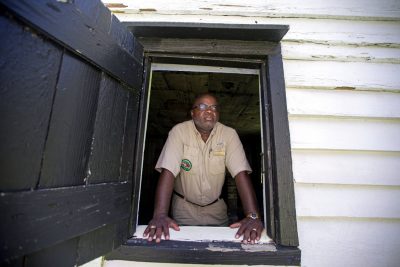
On August 14, 2015, I read an article in the home-delivered New York Times “A Journey to Enclaves of Slavery in the North.” I cut out the article with the intention of writing a blog on the subject at some point in the future. That time has now arrived and naturally I was unable to find the clipping. Fortunately, there is on-line. That version was entitled “Confronting Slavery at Long Island’s Oldest Estates.”
Joseph McGill, the founder of The Slave Dwelling Project, had his first encounter with sleeping in a slave dwelling in 1999. He was participating in a documentary about Civil War re-enactors and the controversy over the Confederate battle flag. The producers asked McGill about adding something special to the production. A slave cabin provided the answer. He recounts the experience of sleeping in it:
The floor was very hard, and the bugs were terrible. I woke up at about 3 a.m. to the sound of dogs barking in the distance. I’m not sure ‘spooky’ is the word, but the thought did run through my head of all those who had tried to escape.
Eleven years later he leveraged that experience into the Slave Dwelling Project. His goal was to fill what he calls “a void in preservation” at Southern plantations and beyond. At the time of this article in 2015, McGill had slept in more than 70 slave dwellings in 14 states since the inauguration in 2010. He had done so alone or in groups as large as 30. At times a group might consist of both the descendants of slaves and slave owners. The article was about his first foray into New York where he would bed down on three historic properties on eastern Long Island. The remainder of the article details the upcoming events at the three sites: JOSEPH LLOYD MANOR, in Lloyd Harbor, SYLVESTER MANOR, in Shelter Island, and THOMAS HALSEY HOMESTEAD, Southampton. Part of the story is the reminder that, yes, there was slavery in the north.
On September 14, 2018, at the Museum Association of New York (MANY) Mid-Hudson Region Re-Visioning Change Workshop held at SUNY New Paltz, Historic Huguenot Street presented on its application of The Slave Dwelling Project. It did so with TMI, a local mental association organization which uses storytelling in its therapy. This presentation was the impetus for me finally writing about this effort.
Their first one in 2016 included descendants of Huguenots and Africans. Kara Graffen, Director of Public Programming at Historic Huguenot Street, noted Africans had arrived here with the Dutch even before the Huguenots had arrived. The average Huguenot family owned one to four slaves. The staff used Sojourner Truth’s journals to reconstruct slave life. The slave cellar would have had a table, furniture, fireplace and sleeping areas. As reported in New York History Blog, “Slave Dwelling Project Shines Light on Northern Slavery”:
Six SUNY New Paltz students and several members of the public will be invited to join McGill and his associate Terry James [a living historian and member of the board of The Slave Dwelling Project] [on September 9, 2016] to share in this symbolic return to a time when even northern households enslaved Africans.
The next night, on September 10th, the Historic Huguenot Street non-profit organization will host a special reception, during which McGill and James will discuss the previous night’s experience in the 300 year-old cellar at Huguenot Street and their mission to preserve historic slave dwellings. Additionally, Historic Huguenot Street will unveil for public viewing a steel slave collar, donated in 2010 by a descendant of the historic site, that was owned by the very same family — the Hardenberghs — that once enslaved renowned abolitionist and former Ulster County resident Sojourner Truth.
Some accommodations had to be made to meet safety requirements. For example LED lights were used so participants finding it necessary to exit the cellar during the night would be able to do so without endangering themselves on the stairs or outdoors. Also it helps to do this on a nice summer day and not in the dead cold of winter. The actual slave experience is re-created only up to a point. Still one should not underestimate the powerful impact of spending a night in the actual space where the slaves did had to those receptive to the experience. It is not a Halloween haunted mansion but an immersion into history (not that Historic Huguenot Street is against revenue-producing haunted mansion experiences either).
For the 2017 program, they decided to revise the experience to include sharing it. After Juneteenth, 2017, six writers participated an immersive program. They slept in the same slave quarters as in 2016. Once again James participated. The outcome of this experience was shared with the public at the Reformed Church of New Paltz on September 16, 2017. Some of those outcomes were shared at this MANY workshop.
By coincidence, a few days ago, the fifth annual Slave Dwelling Project conference was held at Middle Tennessee State University (October 24-27). The focus of the conference went beyond the slave dwellings themselves to examine the topic of slavery in the United States and its influence on American society and culture. McGill said:
Now that I have the attention of the public by sleeping in extant slave dwellings, it is time to wake up and deliver the message that the people who lived in these structures were not a footnote in American history.
The Slave Dwelling Project Conference was right to expand the scope of the conference. It is important that the overnight experience not simply be a stunt or gimmick to be checked off on a cultural do-gooder bucket list. The dwelling is actually part of a larger story of slavery in the United States.
Michael Groth, a history professor at Wells College in central New York, grew up Dutchess County and wrote a book Slavery and Freedom in the Mid-Hudson Valley (SUNY Press 2017). In an article “Slavery’s Hidden History in the Mid-Hudson Valley Coming to Light,” (Poughkeepsie Journal, April 25, 2018), by reporter John Barry, he turned to Groth and his book as a source for background information on a current dilemma in New Paltz.
State University of New York at New Paltz is examining its connection to the region’s troubled past. At the heart of the ongoing debate is the Huguenot history and the families that helped settle the area and launch the college. At question is whether the college is honoring local history through buildings named for founding families from the area, or ignoring the slave-owning history of these settlers.
College officials are conducting a review of campus buildings named for Huguenot families that owned slaves. Since he launched the initiative last year, SUNY New Paltz President Donald Christian said he has heard from students of color who are uncomfortable eating in a dining hall and sleeping in a residence hall named for families that once included slave owners. “Many people are surprised to learn that slavery was such a prominent feature of the Hudson Valley,” Christian said.
This limited understanding “contributes to the ability of some people to overlook that history.”
“People of color, particularly African Americans, feel like it’s a piece of their history that much of the rest of society is not acknowledging,” Christian said. “And many white people, perhaps especially of younger generations, share that perspective. These are reasons that this entire history should be told fully and honestly.”
A few months earlier, more than 60 people had turned out for a night meeting at the college that focused on an issue that had been brewing for years before it evolved into a formal review last year. The nearly 90-minute discussion was framed by impassioned arguments on both sides of the issue. Christian said:
This is the kind of respectful, open dialogue where different views are aired to inform our collective understanding of a really complex situation that bridges history and contemporary issues and concerns. This is very much what I had in mind as developing. I’m heartened by what transpired here.
Regardless of the final results of SUNY New Paltz’s examination into its slave past, the larger point is the overnight sleeping in the slave quarters should only be part of the experience of connecting people in the present to the historical reality of slavery in the past including in the north.
SOURCES
2015
Confronting Slavery at Long Island’s Oldest Estates https://www.nytimes.com/2015/08/14/arts/confronting-slavery-at-long-islands-oldest-estates.html
2016
Slave Dwelling Project Shines Light on Northern Slavery https://newyorkhistoryblog.org/2016/09/01/slave-dwelling-project-shines-light-on-northern-slavery/
2018
SUNY New Paltz: Buildings named for slave owners spark debate https://www.poughkeepsiejournal.com/story/news/2018/01/26/suny-new-paltz-buildings-named-slave-owners-spark-debate/1068104001/
Slavery’s hidden history in the mid-Hudson Valley coming to light https://www.poughkeepsiejournal.com/story/news/2018/04/25/suny-new-paltz-slavery-hidden-history-hudson-valley-coming-light/506377002/
Slave Dwelling Project Conference http://slavedwellingproject.org/2018-slave-dwelling-project-conference/
Contact Email: sdpcon2018@gmail.com





